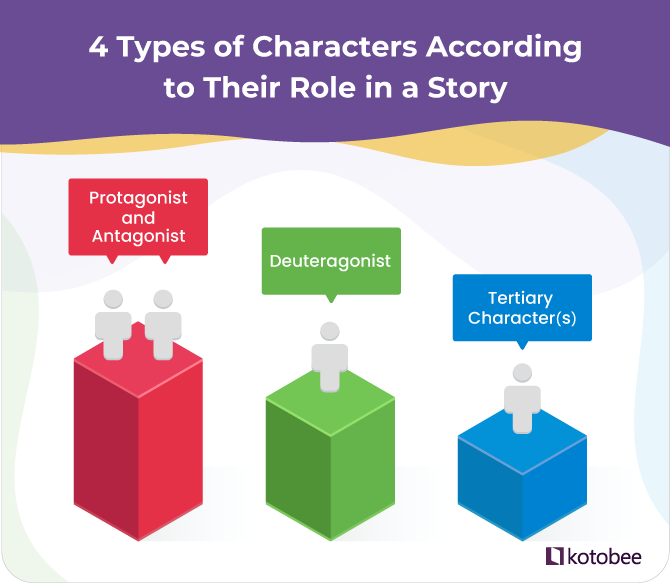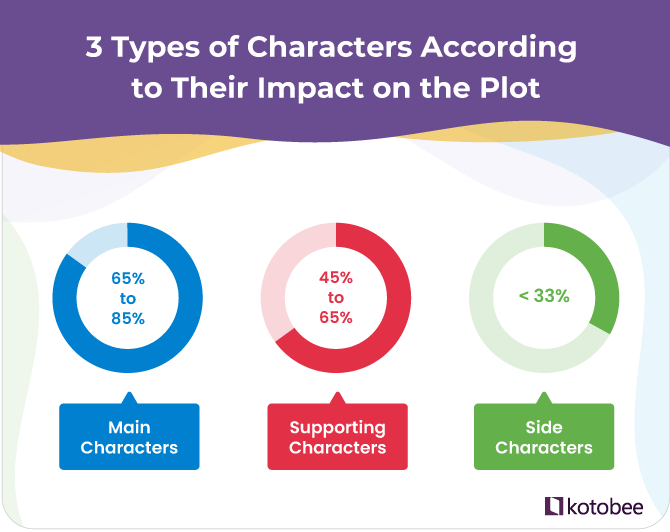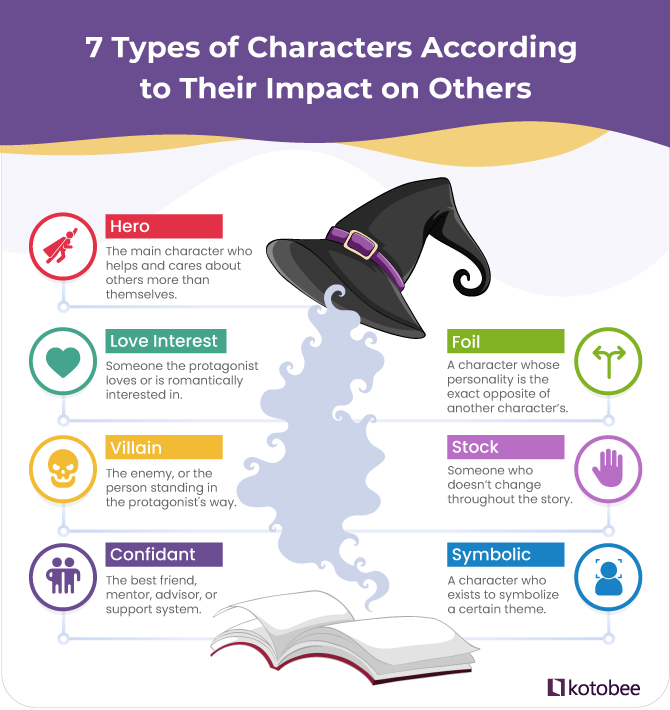The Different Types of Characters in a Story Explained
Characters serve as the soul of any story. They are the changemakers, the chess pieces that act and react to one another in a chain of events known as the plot. So, it’s quite important to know the different types of characters in literature and how to create them.
As you’re writing your story, you will find yourself giving your characters certain roles or making some of them more important to the plot than others. In turn, the more important characters will feature in most scenes, while less important characters will only appear from time to time. With practice, you will eventually learn to insert the right types of characters in the right places without giving it much thought.
To help you do that, we will explore the different types of characters in a story. We’ll use three classification systems: their significance in the story, their importance to the plot, and their relationships to one another.

Why Should You Know the Different Types of Characters in Fiction?
Understanding various character types can help you create more compelling characters. Since each type plays a distinct role in a story, choosing a certain role significantly impacts the character’s feelings, actions, and importance to the narrative. Additionally, knowing these types allows you to differentiate between characters with similar personalities, as their roles within the story may vary.
To help you understand all the different types, we are going to explore three approaches to classifying characters. Why three? Because a single character can represent multiple types at the same time. For example, a single character might be the protagonist, one of the main characters, and even a villain. Another character could be both a deuteragonist and also a symbolic main character.
These diverse roles add layers of complexity and depth to each character. So, relying on just one classification system limits the amount of personal depth we can infuse into our fictional creations.
The 4 Types of Characters According to Their Roles in a Story
In this section, we’ll define the different types of characters according to the choices they make and the effects of these choices on the plot.
1. Protagonist
A protagonist is the main character whose journey we follow throughout the story. To make that journey more interesting, writers add depth and weight to the protagonist’s personality, backstory, and any growth they experience in the story. So, we often form attachments to these characters and like to see them become better people or succeed in achieving their goals.
However, not all protagonists embark on epic journeys or have likable personalities. Some of them turn out to be quite dreadful people! Shakespeare’s Macbeth, for instance, starts out as a noble general who becomes consumed by greed and ambition as he tries to secure the throne for himself.
2. Antagonist
Wherever there is a protagonist, there is also an antagonist who causes conflicts that get in the way of the protagonist. While antagonists typically possess evil intentions or plans, there are instances where they turn out to be good guys (especially when the protagonist is revealed to be the true villain).
A good example of a classic antagonist is Sir Leigh Teabing from The Da Vinci Code. He is secretly the mastermind behind the murders of the Priory of Sion members who protect the Grail.
3. Deuteragonist
A deuteragonist is a character who is important to the story but not enough for the story to focus entirely on them. While not quite the main character, a deuteragonist has their own independent story to tell. They usually appear as affiliates of the protagonist or antagonist, but they could function separately from both. You can say that they come right after the protagonist and antagonist in terms of importance.
Some well-known examples of deuteragonists are Dr. Watson from Sherlock Holmes and Harvey Dent in The Dark Knight.
4. Tertiary Characters
These characters have small roles in the limited scenes they appear in. Though tertiary characters may seem unimportant, you have to give them enough weight so their role in the scene is meaningful. These roles can range from comic relief to kickstarting plot events. As an example, think of a waiter serving the protagonist’s table, a pilot flying the antagonist’s plane, or a villager buying from a nearby market stall.
The unlucky cabbage vendor from Avatar: The Last Airbender is one of the most memorable tertiary characters among fans of the show. His appearances, while brief, turn into running gags that never fail to make the audience laugh.

3 Types of Characters According to Their Impact on the Plot
In any story, a character’s importance can be determined by their impact on the plot or other characters. Generally, characters with higher impact appear more often in the story than others. Based on this, we can categorize characters into three types according to how often they appear in the story.
1. Main Character
This character type takes up more than two-thirds of the story in scene time and participates in most of the plot events. Protagonists, antagonists, and even deuteragonists—depending on their story arcs—can count as main characters.
Harry Potter is a popular example of a main character whose journey we follow in depth throughout an entire book (and franchise).
2. Supporting Character(s)
While less important than the main character, these characters still play important roles in the story and usually appear in about half of the plot events.
They can act as close friends, advisory figures, or even minor villains who support the antagonist. As such, deuteragonists, minor antagonists, and some tertiary characters fit into this category. Think of Ron and Hermione, who accompany Harry Potter throughout their years at Hogwarts.
3. Side Characters
These characters take up no more than a third of the story if not just a scene or two. Thus, they tend to serve minor roles and often don’t stay long enough to leave lasting impacts on story events. Remus Lupin and Luna Lovegood from Harry Potter are considered side characters because their screen time is much less than others.

7 Types of Characters According to Their Impact on Others
Finally, we will talk about character types as specified by their behaviors and relationships with others. While these characters may not be solid archetypes, the following classification will help you understand how they interact with one another.
1. Hero
A hero is a person whose mission is to help others in any capacity. They may perform acts of kindness such as giving generous donations to a charity, brewing coffee for a tired coworker, or rescuing a child from kidnappers.
When a character acts as a hero, they rely on their morals to do the right thing, putting others’ well-being before themselves even at their own expense.
Heroes often serve as the protagonists in a hero-vs-villain story, like Frodo from Lord of the Rings.
2. Love Interest
Although not all stories contain romance, many characters may want to pursue a special someone. This love story could serve as the main plot or a side arc, depending on your book’s genre and the characters’ personalities.
As with other central characters, love interests should be developed thoroughly when introduced into the story. They should also be given the same level of depth and complexity to make them compelling and memorable. After all, it’s that complexity and intriguing personality that turned Catherine Earnshaw from Wuthering Heights into a compelling love interest. It also contributed to the novel becoming a popular and well-loved classic.
3. Villain
Whether they scheme in their towering castles or scare people with one look at a corporate meeting, villains add higher stakes to a story by introducing external conflict. They could be evil beyond redemption or have a few good traits that make them seem more human.
In all cases, villains tend to cause big problems throughout the story, just like the Joker does for Batman through breaking out of prison and terrorizing the city.
4. Confidant
Confidants offer a support system for the main characters, grounding them when they fall or doubt themselves. They can appear as their best friends or mentors, and they offer support and encourage the protagonist to overcome any obstacles in their path. However, they might also serve as cunning advisors to the villain of the story as well.
For example, Mr. Miyagi serves as a confidant to Daniel in The Karate Kid, teaching him both physical martial arts and the mental skills to go with it.
5. Foil
A foil is a character whose personality, actions, or existence contrasts with that of another character. Writers often use foils to emphasize certain qualities in a character, whether it’s the protagonist or others. As a result, foils are more effective when they appear frequently and interact with the character they are designed to contrast.
One of the clearest examples of such a character is Helen Burns in Jane Eyre, who serves as a foil to the school manager, Mr. Brocklehurst. She is kind and forgiving, whereas Mr. Brocklehurst regularly punishes and screams at students even if they did nothing wrong.
6. Stock Characters
Stock characters are typically flat and experience no character growth throughout the story. Accordingly, they maintain their shallow and predictable personality traits beginning to end. You may know stock characters as stereotypes, archetypes, cliches, or simple, flat characters that have no complexity to them.
Given that they don’t experience character growth, stock characters are ideal for one-off scenes or plotlines in which character growth is unimportant to the story. When you use a stock character in a scene, you emphasize the plot events happening to them instead of the character’s reactions to these events.
Dr. Frankenstein from Frankenstein, for example, is a true mad scientist whose passion for science steered him into unethical experiments that created a monster. Despite facing severe problems because of his experiments, Dr. Frankenstein’s shallow personality remains the same until the end. Additionally, the center point of the story is the experiments, not the man himself.
7. Symbolic Characters
Finally, we have symbolic characters whose main purpose is to illustrate a specific idea or concept. Their actions—which are often exaggerated—tend to emphasize a certain theme in the story.
For instance, a character may symbolize determination and courage by refusing to give up their quest in the face of impossible odds. Another character may represent the concepts of greed and corruption because they profit off of illegal business practices.
One good example is the White Rabbit from Alice in Wonderland, who constantly checks his pocket watch and rushes from place to place, thus symbolizing the importance of time.

Final Thoughts
Learning about the different types of characters in fiction can help you design well-developed ones and come up with suitable conflicts in the long run.
To understand the various types of characters in fiction, you can read your favorite books and point out character roles you didn’t give much thought to before. Doing this can help you learn how characters’ roles can affect their actions and help move the plot forward. You also get to see for yourself how diverse just one character type can be!

.
Read More
What Is a Memoir and How to Write an Outstanding One?
Writing a Novel in A Month: NaNoWriMo 2025
10 Practical Tips for Mastering Humor Writing















